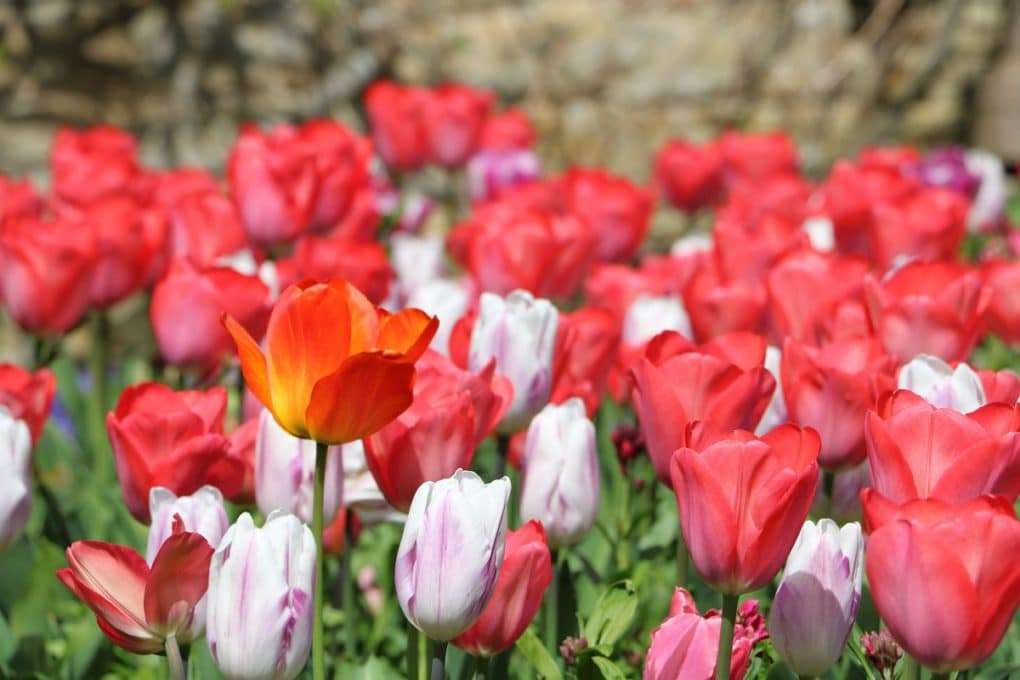

As the Tulips at Hever Castle reach their peak blooming period, Head Gardener Neil Miller shares his knowledge on tulip history.
It could be said that Hever Castle & Gardens is the perfect place for showcasing tulips.
Speaking to our Conservation Assistant Alison Palmer, and looking through the gardening history books, we know that the tulip was officially introduced into the Tudor gardens of England in 1578.
John Gerard’s ‘Herballor General Historie of Plantes’, a book detailing plants of Tudor times, actually lists the plants in his own garden as including 30 different species of tulip.
As the Tudor world expanded, so did the Tudor garden which saw a transformation in the 16th century thanks to the arrival of new species brought from Spain, France, Turkey, Portugal and eventually the Americas.
Owners of country houses and Castles, such as Hever, would have been keen to have had the latest and most fashionable of plants – especially the newly arrived tulip from Turkey.
One particular artefact of interest at Hever Castle which details the importance of the tulip in regal circles is the portrait of Margeurite de Valois which features tulips on the bodice of her dress. Marguerite was the youngest daughter of Catherine De Medici, queen consort of France from 1547 – 1559 by marriage to King Henry II. The portrait of Marguerite, in her tulip embroidered dress, was brought to Hever by former owner William Waldorf Astor over 100 years ago and now hangs in the Inner Hall at the Castle.
The tulip really began to find its roots in England’s garden history from the 1630s onwards.
As ‘Tulipmania’ swept through the Netherlands in the 17th Century its effect was felt in England as tulips became a feature of the plant collector’s garden.
Tulips of all colours were introduced across the centuries and we are now in the position to be able to plant huge block colours or to go mad and plant a kaleidoscope of colours interspersed with other spring bulbs, if we so choose.
The tulip has been beloved by the Italians since the 1500s so it is perhaps fitting that the dramatic Italian Garden at Hever plays host annually to the largest of the tulip planting displays. This part of the garden was designed and built in 1904 -1908 to showcase Astor’s unique collection of statuary and sculpture which stretches to 200 pieces, some of them over 2,000 years old.
Charles Darwin and his home Down House in Kent also features in tulip history or more accurately Darwin’s wife Emma who selected them for their garden. Interestingly, despite there being no evidence of Darwin studying these flowers, there are two groups of tulips named after him: ‘Darwin’ and ‘Darwin Hybrids’.
Tulips became popular again in Victorian gardens and later again in the 1930s. We know that Astor was a big fan of the daffodil bulb (a bulb with far greater longevity) so it’s not a stretch of the imagination to believe that Astor may have been a fan of the tulip too.
And we create our own tulip history today where we grow over 25,000 tulips in the grounds at Hever Castle & Gardens and hope our displays will help to keep this fantastic flower in vogue in the 21st century.
If you enjoyed this article about tulip history and are keen to learn more about tulips, then why not read about:
Tulip pest control
Book your visit to Hever Castle & Gardens.
Within the grounds of the Hever Castle Estate, there are two opportunities for you to stay the night with us.
Hever Castle has played host to many important events and celebrations for over 600 years. In 1903 when William Waldorf Astor set about restoring Hever Castle to its former glory, he added the Astor Wing, to accommodate his family and guests, before creating a lake and the spectacular Italian Garden to house his impressive collection of ancient Greek and Roman statuary.
There are multiple places to eat & drink across the Hever Castle Estate. Select between the Castle & Gardens and Golf Club below to discover more.
Set in the mature grounds of the Hever Castle Estate, Hever Castle Golf Club is a 27 hole Kent golf course that will encourage and inspire all golf enthusiasts.
Set in the mature grounds of the Hever Castle Estate, the Wellbeing Centre consists of five smart treatment rooms.